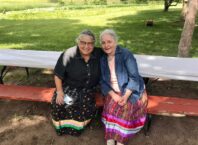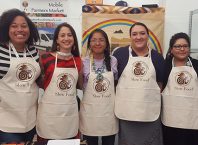A new Native American garden is growing this summer at the University of Minnesota, Morris Crocus Valley Gardens. The gardens are adjacent to the campus. Part of a multi-garden plot, the tradition "three sisters garden"- corn, beans, and squash – shares space with community gardens maintained by the UMM Student Organic Gardening Club and the Regional Fitness Center (RFC). The native garden project was coordinated through the Morris Healthy Eating Initiative and the Office of Community Engagement in partnership with the West Central Research and Outreach Center.
Donna Chollett, associate professor of anthropology and Latin American area studies coordinator, said former student Daniel Hart initiated the idea in 2008 as a service-learning project in her Culture, Food, and Agriculture course.
The Community Food Assessment conducted in 2009-10 by Morris Healthy Eating considered the barriers to gardening. Under the guidance of Mary Jo Forbord, Morris Healthy Eating coordinator and organic farmer, the project’s vision is "to make fresh fruits and vegetables and other healthy foods the easy choice for every meal every day for UMM students, as well as for the residents of Morris and Stevens County no matter their income or age."
Results of the assessment indicated that 50 percent of students would eat more fruits and vegetables on campus if they had access to a garden to grow their own, and American Indian students were among those showing the highest interest in gardening access. They also believed their diets would be healthier if the food was produced in their traditional ancestral ways.
American Indian students comprise 12 percent of the student population. Morris is the only university in the upper Midwest qualifying for designation as a Native American Serving Non-Tribal Institution.
This spring, students from Chollet’s Culture, Food, and Agriculture course participated in a service-learning project on researching and designing the Native American garden. Students from the class, from the Circle of Nations Indian Association, and staff members attended the Indigenous Farming Conference on the White Earth Indian Reservation in March 2011 to gain perspectives and knowledge about Native American gardening.
The class also studied the differing food ways of the Anishinaabe (Ojibwe) and Dakota (Sioux) tribes whose traditional lands covered Minnesota and the Dakotas before the coming of Europeans, as well as other tribes with traditions of gardening and food cultivation.
Francis Gary Bettelyoun, coordinator of the University of Minnesota Twin Cities traditional Native American garden, visited Chollett’s Culture, Food, and Agriculture class this spring to advise students. Bettelyoun is an enrolled member of the Yankton Nation and vice president of Buffalo Star People in Spencer, South Dakota, an organization that offers native landscape design, based on traditional and organic concepts, and community gardening.
Tracy Peterson, associate director of Morris’s Multi-Ethnic Student Program, diagrammed the garden’s plan in a contemporary Cayuga Iroquois system of arranging the "three sisters" in a particular relationship with each other. Corn will not be sown in the adjacent community gardens to avoid cross-pollination with the white flint corn gifted by Winona LaDuke, founder of the White Earth Land Recovery Project.
Gabe Desrosiers (Ojibwe), a Morris lecturer in Anishinaabe (Ojibwe) language and culture, performed a blessing ceremony in June 2011 before planting the native garden. Placing it in historical perspective, he related that tribal nations traditionally performed a blessing when they left for their seasonal grounds.
"The spiritual ceremony before planting is to ask the Creator to bless the seeds that are put into the ground so that it will grow in a good way. Both the ground and the seed are blessed so there will be a good crop. A tobacco or sage offering is burned to bless the grounds in all four directions because in every direction there is a spiritual door. The door is the opening for the spirits to come in. The tobacco offering and cleansing the ground with sage is asking in a good way," he said.
Kali Dale, of Bemidji, was student coordinator for the event and will lead the work with the Native Garden this summer through Morris Healthy Eating. She is active in Morris’s Circle of Nations Indian Association, American Indian Science and Engineering Society, and National Science Foundation funded STEP program.
In attendance at the garden blessing and planting were Morris faculty, staff, students, as well as high school students from the White Earth Indian Reservation and Native high school students participating in the Morris Wind STEP Program, a National Science Foundation funded pipeline to STEM fields for American Indian youth.
Alissa Jacobsen, of Stillwater, is president of the Student Organic Garden Club and leads the Crocus Valley Gardens initiative on the Morris Healthy Eating Student Leadership Team. As a student in Chollet’s 2011 spring course, Jacobsen worked with other students to research Native American food traditions and growing methods prior to proposing a design for the Native American garden.
She envisions the Native garden’s future in her class essay, "I hope that the garden will never stop evolving. It will be different every year, with the rotation of plants and different people working on it from year to year. I think that one of the main goals of the garden is to keep the plans for it flexible so that it can cater to the needs of the community and to whatever new information people discover about Native gardening… All in all, I imagine that the garden is a beautiful place where people can go to enjoy the earth, good food, and good company."
Morris’s American Indian student gardeners will seek guidance from their tribes’ elders to help the garden grow. They want to share the garden’s harvest to support good food and good health for Native students and their families, for the campus, and for their tribal communities.
Morris Healthy Eating is supported by Blue Cross and Blue Shield of Minnesota (Blue Cross) through Prevention Minnesota, Blue Cross’ long-term statewide health improvement initiative. Tobacco settlement proceeds fund this work to tackle the root causes of preventable heart disease and cancer.
Read more about the Healthy Eating initiative at: morris.umn.edu/healthyeating.






